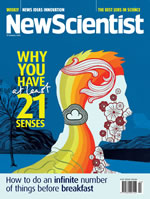I strongly agree with Easter Russell (8 January, p 25). There should be a media code of practice requiring that all simulations, artist's impressions and so on are clearly marked as such. How authentic are the pictures of Titan we are being shown from Huygens?
New Scientist could set a good example by stating when its pictures are not real - for example, that of comet Tempel 1 on p 28 of the same issue.
From Roger Taylor
I agree completely with Russell, and the sooner the better. Modern imaging technology is so powerful, and presumably will become more so, that it could lead to all manner of fraud and deception, and ultimately to an Orwellian rewriting of history. This is not something we should tempt our politicians with.
Meols, Cheshire, UK
From Peter Strickland
It is a mistake to think of films or photographs as real. When you take into account the choices that go into what to point the camera at and when to film, there is an enormous amount of subjectivity involved. Then there are choices about zoom, focus and aperture, which all affect what is seen and how it is portrayed. And then, of course, the resulting film or photograph will be edited, which will involve various digitally applied modifications, and, in film, choices about timing, sequences and so on.
The difference between photography and digital imagery is more of a perceived idea about authenticity than any practical difference.
Leeds, UK
From Stu Witner
Once begun, where does one stop, I wonder? For example, all images from the Hubble Space Telescope are "simulated" in that the colours are computer generated. The colours are not only beautiful but enable researchers to learn much more from them than if they were "real".
Then there is the philosophical argument, "what is truth?", not to mention the obvious public taste for drama over reality. I'm afraid Russell may be tilting at windmills, 21st-century style.
Seattle, Washington, US

- Like what you've just read?
- Don't miss out on the latest content from New Scientist.
- Get New Scientist magazine delivered to your door, plus unlimited access to the entire content of New Scientist online.
- Subscribe now and save
If you would like to reuse any content from New Scientist, either in print or online, please contact the syndication department first for permission. New Scientist does not own rights to photos, but there are a variety of licensing options available for use of articles and graphics we own the copyright to.
Have your say
All comments should respect the New Scientist House Rules. If you think a particular comment breaks these rules then please use the "Report" link in that comment to report it to us.
If you are having a technical problem posting a comment, please contact technical support.







